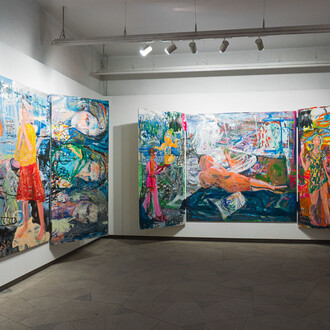The images I perceive, saturated with murmurs, take on form through a kind of a lineup. Neat rows of paintings ripple across white walls, much like the core of a mechanical pencil dragging a line along the edge of a ruler on white canvas or paper. Relying on precise tools and pre- defined measurements, I can structure complex, seemingly ungraspable images and to comprehend my surroundings. In the studio, I work slowly and attentively, allowing the image to be experienced not instantly, not at a glance, but gradually and calmly – inviting reflection on its relationships, its light, its rhythm.
Manifestations of order emerge through placement, arrangement, sequence, and row – through the sense of things being ‘just right.’ A multitude of noisy impressions from art practices gathered into one booklet; countless road motifs predictably leading from one point to another; clusters of wooden houses, woodgrain ripples layering upon each other; long straight and taut lines in flowing water, in the rows of chairs and clothes that echo canvas weaving and become the essential image. I trace them all through a continuous visual basso continuo (a digital bass resonating steadily beneath a multitude of instrumental voices).
The motifs of reshaped and reimagined nature of orchestrated movement leave behind certain traces – a coded pattern of recurring order and logic – a lineup I discover through close observation, step by step, methodically, almost like a detective: remembering, searching for meaning, unearthing new resonances. As if carefully brushing off the dust left by chaos, as if removing bothering dirt and visual noises with tweezers – I bring the structure into the light (Aurelija Zaburaitė).
















